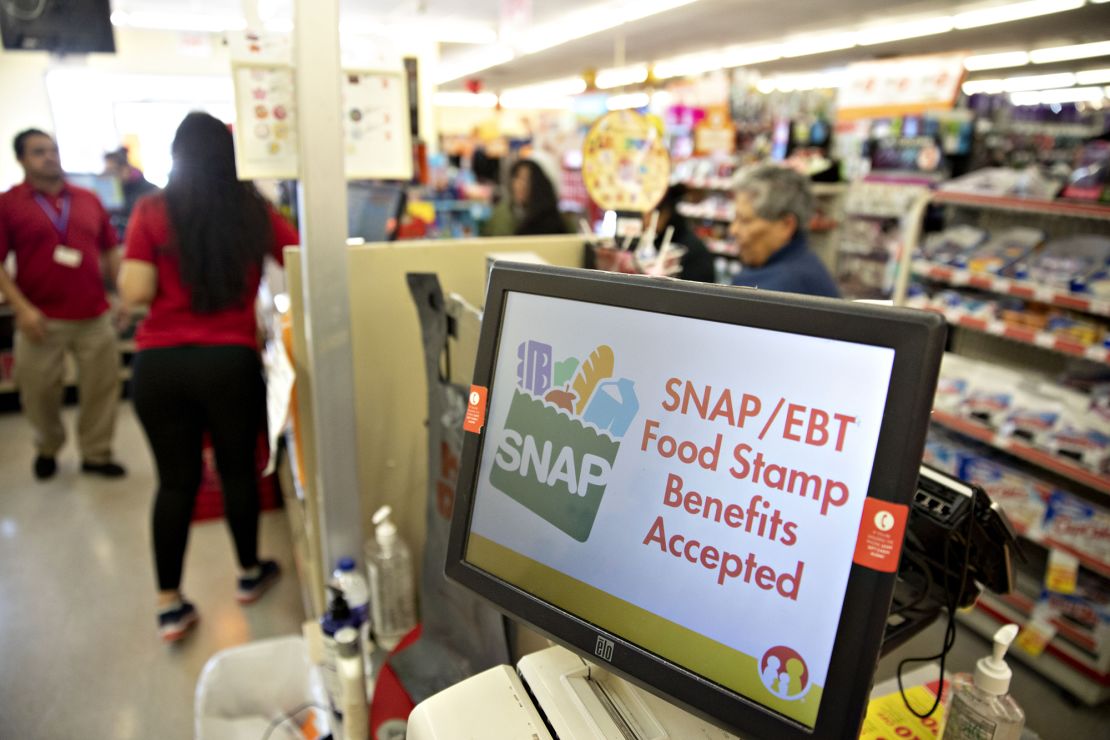Richard Smith wishes he could buy his groceries online and get them delivered right to his door in the pandemic. It’s not so easy.
Smith, 74, is retired and has COPD, a chronic lung disease. He has trouble breathing from his years of smoking cigarettes. In September, he was hospitalized for his condition.
Twice a month, Smith, who doesn’t have a car, goes with an aide in Lynn, Massachusetts, to Market Basket, a local supermarket chain, to pick up food and essentials. The $194 a month he receives through the Supplemental Nutrition Assistance Program, commonly known as food stamps, helps him afford his groceries.
But Smith is frustrated he can’t order for delivery instead of risking exposure to coronavirus when he visits the store. “It’s more convenient, and I don’t have to depend on anybody,” he said.
However, Market Basket does not offer delivery directly itself. Instacart offers delivery from some Market Basket stores, but only accepts SNAP as part of a limited pilot with some Aldi stores. (A spokesperson for Market Basket said in an email the company was assessing delivery.) In Massachusetts, shoppers can only use their benefits to order online from Amazon and Walmart under a pilot program started in 2019 by the Department of Agriculture, which administers SNAP.
That doesn’t work for Smith, who is also a member of Massachusetts Senior Action Council, an advocacy group for low-income seniors. Walmart doesn’t deliver to his home and he says he can’t afford Amazon’s prices on items like milk and fish. Amazon also charges a fee on orders under $35, and the Agriculture Department prohibits SNAP recipients from using benefits to cover delivery fees or tips.

Smith’s barriers highlights the access gap in online grocery shopping among the more than 40 million people who rely on SNAP at a moment when buying food online has become more popular with wide swaths of the public in the pandemic. SNAP eligibility varies by state, but typically households must be at or below 130% of the federal poverty line —about $2,800 in gross monthly income for a family of four-— to qualify for assistance, according to the Agriculture Department.
Many SNAP recipients, including older people and people with disabilities, won’t have the ability to participate and shop online because they do not live in states covered by the Agriculture Department’s online program or are in areas outside of retailers’ delivery zones. Advocates say many SNAP participants who are eligible to buy groceries online using their benefits face other challenges, such as internet access, lack of experience using a computer or few places to drop off deliveries.
“It’s one of the biggest failures in the pandemic right now. There’s one system for people who have SNAP and another for people who don’t. It’s really frustrating,” said Lucia Leone, assistant professor in the Department of Community Health and Health Behavior at the University at Buffalo.
Online expansion
The disparities come at a time when concern is growing over rising coronavirus cases, especially in poorer neighborhoods.
Grocery stores have emerged as a primary place of coronavirus infections, according to a study published in the journal Nature last month that analyzed cellphone mobility data of 98 million people. The study found that grocery stores in low-income neighborhoods are likelier places of coronavirus spread than stores in higher-income areas. This was because grocery stores in lower-income neighborhoods had 60% more people on average by square foot and shoppers stayed in them longer.
The 2014 Farm Bill authorized the Agriculture Department to study an online SNAP purchasing pilot, but the pilot was not launched until last year. Since debuting in New York with Amazon and Walmart, the Department of Agriculture has rapidly added dozens of states to the online SNAP pilot in the pandemic, and more than one million SNAP households bought groceries online in September.
Today, 46 states and the District of Columbia allow SNAP recipients the ability to use their benefits online, but Amazon (AMZN) or Walmart (WMT) are the only retailers that offer delivery in the majority of those states. The agency announced last month that more grocers, including Safeway, Aldi, H-E-B and several smaller grocers, would be added to the program.
Walmart, Kroger, Hy-Vee and other chains also accept payment through SNAP for curbside pickup orders, but that is a challenge for those without a car, people with disabilities, elderly citizens and others who are homebound, say advocates for people on SNAP.
Advocates applaud the Department of Agriculture for acting quickly to bring additional states and retailers onto the pilot in the pandemic. But they say there are still few options for people on food stamps to order from, especially when it comes to small and local grocers. Illinois Senators Richard Durbin and Tammy Duckworth introduced a bill in July that would provide $100 million in funding to develop an online portal for SNAP customers to use their benefits and create a program to help small retailers, direct-to-consumer farmers and farmers’ markets get setup.
Small grocers face financial and technological hurdles getting approved by the Agriculture Department to accept SNAP benefits online, say advocates. Grocers have to have websites set up where only SNAP-eligible foods are displayed — not household essentials like toilet paper, which are not covered by the program — and a payment processing system that securely accepts SNAP.
“The cost and the technical difficulty of doing it is very challenging,” said Leone from the University at Buffalo. “It’s too much of a burden on small businesses.”
A spokesperson for the Agriculture Department said the agency is “working quickly to provide SNAP participants the opportunity to shop online for food, the same way many Americans do, with a focus on bringing on new and smaller, independent grocery stores” into the program.
Delivery issues and privacy concerns
Even among people on SNAP who live in areas where Amazon or Walmart deliver, there are obstacles to ordering online and receiving deliveries.
Chloe Arnow, co-founder of the Farragut Food Club, a group of residents in a public housing community in Brooklyn, New York, is working to remove hurdles to online grocery shopping for SNAP recipients.
Arnow said common fears include lack of data privacy and theft. Some people worry that their SNAP dollars could be stolen, she said.

Members of the group have been trying to teach residents how to shop online and create email accounts, but there is often limited WiFi in the community and there are few areas to drop off food if someone is not home. “It’s really hard,” she said. “It basically takes a miracle to get the transaction to go through” when working with someone who hasn’t shopped online before.
There are other concerns. The Center for Digital Democracy, a digital privacy advocacy group, warned in a July report that the online pilot may expose SNAP customers to “increased data collection and surveillance, a flood of intrusive and manipulative online marketing techniques, and pervasive promotion of unhealthy food.”
“The online program is fraught with problems,” said executive director Jeffrey Chester. “The expansion means more data is being gathered and that SNAP participants can be exposed to predatory practices.”
The spokesperson for USDA, however, said the agency has requirements that “protect the private information of SNAP participants” and that it “prohibits retailers from selling or sharing any personal data of SNAP participants.”
The Center for Science in the Public Interest, a non-profit consumer advocacy group, called on the Agriculture Department in a January report to set policies and guidance on how online retailers can market to SNAP customers. The group also urged USDA to ensure retailers that accept SNAP to use price promotions to incentivize healthy purchases and prominently feature those options on their home, search, checkout pages and in emails.
The USDA spokesperson did not respond directly to the group’s recommendations for online ordering, but pointed to existing education programs the agency has place that promote healthy eating and a grant program that provides incentives for SNAP participants to purchase fruits and vegetables.
Correction: An earlier version of this story mischaracterized Market Basket's delivery offering. Market Basket does not offer delivery directly itself. Instacart offers delivery from some Market Basket stores, but only accepts SNAP as part of a limited pilot with some Aldi stores. A spokesperson for Market Basket said in an email the company was assessing delivery.





















